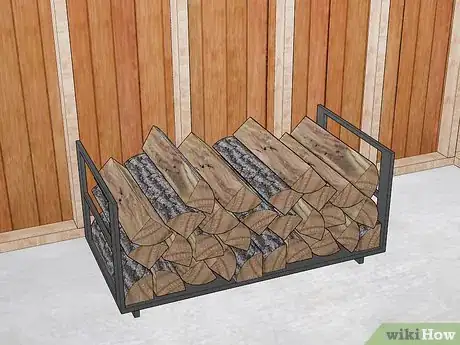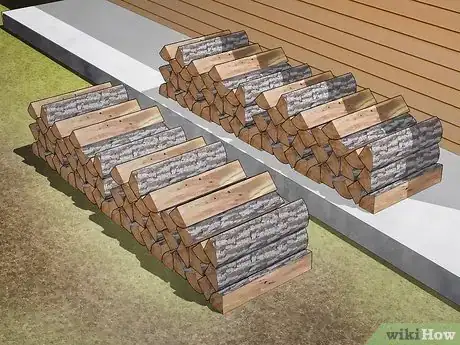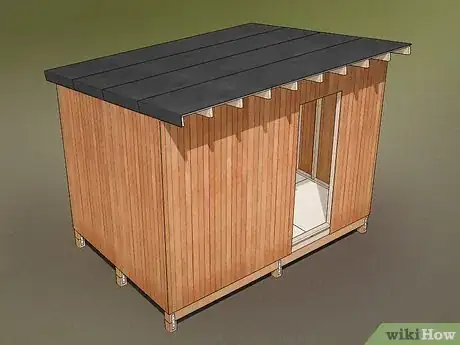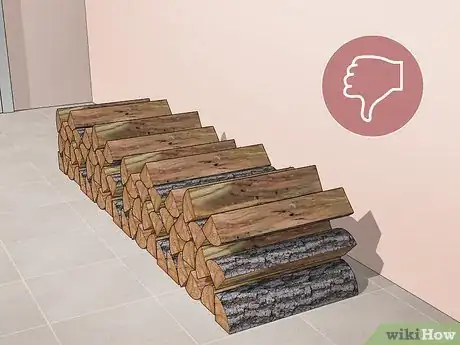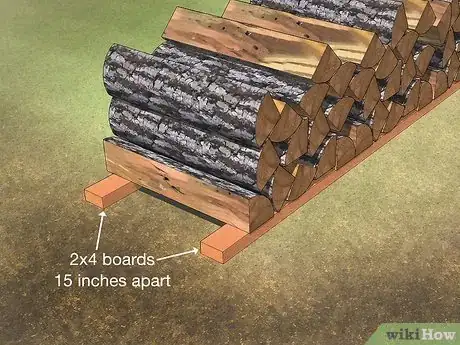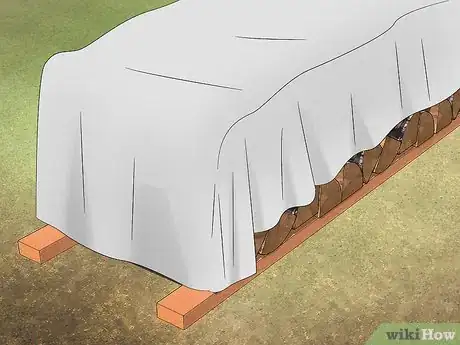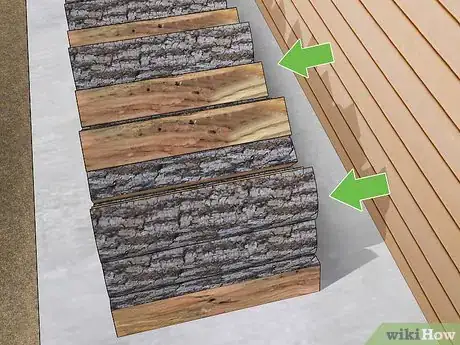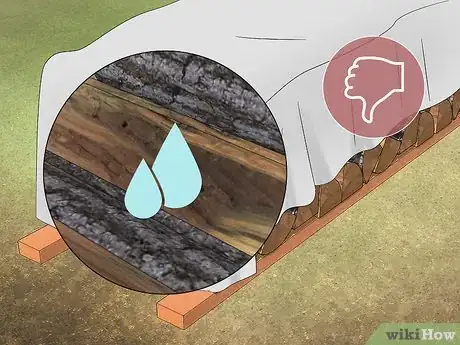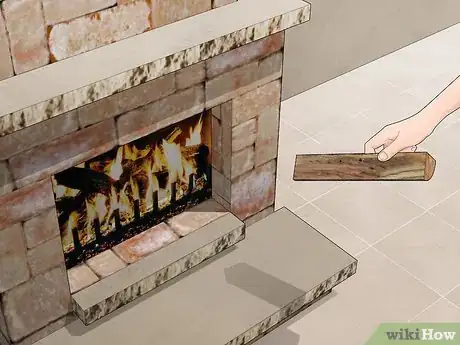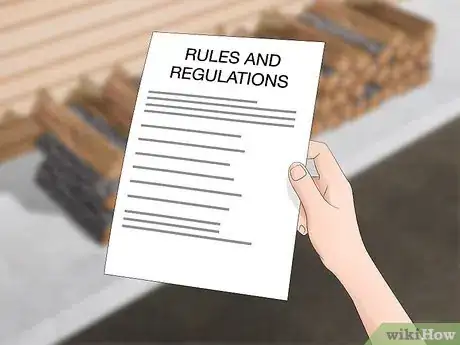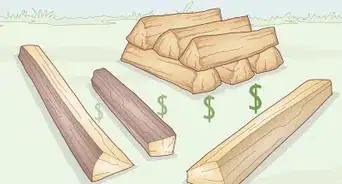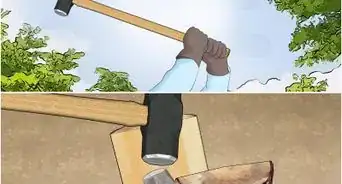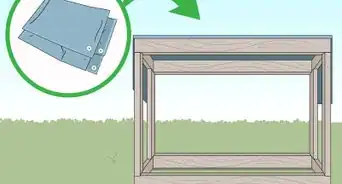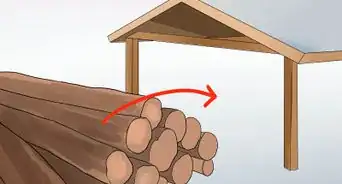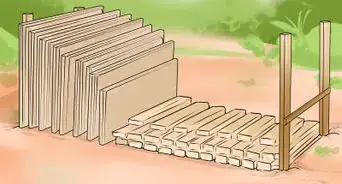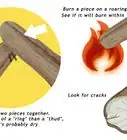This article was co-authored by wikiHow Staff. Our trained team of editors and researchers validate articles for accuracy and comprehensiveness. wikiHow's Content Management Team carefully monitors the work from our editorial staff to ensure that each article is backed by trusted research and meets our high quality standards.
wikiHow marks an article as reader-approved once it receives enough positive feedback. In this case, 89% of readers who voted found the article helpful, earning it our reader-approved status.
This article has been viewed 273,608 times.
Learn more...
Firewood can provide warmth all winter long and a roaring fireplace can create a cozy setting. Storing firewood correctly can protect your wood and create a reserve during cold seasons. If you store firewood outdoors, choose a place near your home that's off of the soil. If you store it inside, choose a storage location like a shed or keep it in a trunk in your home. Make sure to protect firewood from moisture so it will burn effectively when you're ready to light a fire.
Things You Should Know
- Keep the firewood off of the soil since direct exposure to dirt will cause the wood to rot slowly.
- A non-wood shed is ideal when it comes to keeping your firewood clean and dry.
- Stack your firewood in the same direction to encourage air circulation, which will keep the wood moisture-free.
- Cover the wood with a clean tarp when you’re not using it to keep it dry and safe.
Steps
Selecting a Storage Location
-
1Seek out a location close to your home. When storing firewood, it's important to keep convenience in mind. Firewood can be heavy to carry from outside into your home, and this can be especially stressful during the colder months. Seek out an appropriate space away from the home to avoid infestations from termites and carpenter ants, but nearby enough for convenience.[1]
- Keep in mind, if there aren't any appropriate spaces very close to your home, you can invest in a wheelbarrow to make transferring the firewood easier.
-
2Find a location off of soil. When firewood is stored directly on the ground, it will rot quicker. Bacteria and bugs can get into the firewood, causing it to go bad. Look for a place off of soil.
- Surfaces like concrete, asphalt, and clean gravel can be good surfaces for firewood.
- If you can't find any appropriate surfaces, you can use sticks to elevate firewood off of the ground. You can also lay down a tarp underneath firewood.
Advertisement -
3See if there's room in an outdoor non-wooden storage shed. If you have an outdoor storage shed, this a great place to store firewood. Inside a shed, firewood will be protected from things like rain. The shed will also provide a barrier between firewood and the soil. If possible, store firewood in an outdoor shed. Be careful of termites and carpenter ants taking up a home in wooden sheds as they can cause significant structural damage.[2]
- You can also store firewood in your garage.
-
4It is never recommended to store firewood inside homes. Bugs, including termites and carpenter ants, can hitch a ride on the wood and cause significant property damage to wooden structures. [3]
- You can store firewood in an old trunk, if you have one.
- Some fireplaces have compartments built into the wall next to them where you can store firewood.
- Make sure firewood you store indoors is fully dry. If you chopped or collected your own firewood, you should store it outside until it dries. It takes firewood around six months to fully dry out.[4]
Storing Your Firewood Safely
-
1Elevate firewood with 2 by 4 or 4x4 pressure treated boards, if necessary. If you can't find an area outdoors off of the soil, you can easily elevate firewood using 2 by 4 boards. You can buy boards at any hardware store and create a quick storage area for your firewood.[5]
- Lay the boards on the ground about 15 inches apart. Lay down as many rows of boards as you need to stack all your firewood.
- Lay your firewood over the boards, keeping them parallel to the boards. The boards should elevate the firewood off the ground slightly, preventing it from touching the soil.
-
2Use a tarp to protect your firewood from moisture. You should always lay a tarp down over your firewood. You can buy a tarp at any hardware store. Simply lay the tarp over the firewood and tie it down to secure it. You can also weigh the tarp down with something like bricks.[6]
- It's important to allow for some air circulation, as you don't want your firewood to get too dry. You should leave the sides of your stack open to allow for airflow.
-
3Stack firewood effectively. When stacking firewood, make sure to do so effectively. Stacking your firewood incorrectly can cause it to rot quicker.
- You should always stack your firewood rather than throwing it in a pile. This will promote air circulation and keep firewood from drying out.
- Never stack firewood against a wall when stacking it outdoors. This can leave firewood vulnerable to moisture and bacteria. Always leave a few inches of space between your firewood and a wall. Never place firewood against the side of a wooden structure, including your house, because this will invite termites and carpenter ants to feast on your home.
Avoiding Pitfalls
-
1Do not put a tarp over firewood before it's dry. Wet firewood needs to dry out before it can be stored safely. Wet wood needs to be exposed to open air to dry out. If you've just collected firewood, refrain from putting a tarp over it.
- If it's going to rain, it's appropriate to cover wet firewood with a tarp. Just make sure to leave the sides of firewood pile uncovered.
-
2Makes sure your firewood is ready before using it. You do not want to throw wet firewood into your fireplace. Before using your firewood, make sure it's adequately dry.[7]
- Dry firewood will be gray with cracks along the edges.
- Dry firewood will also be much lighter than wet firewood.
-
3Check any local regulations regarding firewood storage. It's possible your city or neighborhood may have regulations about storing firewood. Look over local codes in your area before choosing a storage method for your firewood. You want to make sure you store your firewood legally.
Community Q&A
-
QuestionIf I have firewood stored in a garage, what type of bugs might get into it?
 DonaganTop AnswererIf the wood is old or beginning to decay, it can have termites or carpenter ants.
DonaganTop AnswererIf the wood is old or beginning to decay, it can have termites or carpenter ants. -
QuestionCan we store firewood in a garage?
 DonaganTop AnswererYes, but keep it away from other wood (in case it has pests).
DonaganTop AnswererYes, but keep it away from other wood (in case it has pests). -
QuestionCan I pile the firewood right next to my house?
 Andrew GibneyCommunity AnswerYes. If it is properly stacked and protected from the elements, you should be fine. Always allow proper air flow when stacking close to the wall. Make sure it is elevated off the ground.
Andrew GibneyCommunity AnswerYes. If it is properly stacked and protected from the elements, you should be fine. Always allow proper air flow when stacking close to the wall. Make sure it is elevated off the ground.
Warnings
- Keep children away from firewood stacks and rows. Teach kids that the woodpile is not a place to play.⧼thumbs_response⧽
- Watch for snakes around stored piles of wood. Snakes hide in woodpiles to take refuge from cold temperatures and hide from other predators.⧼thumbs_response⧽
- Firewood can contain termites and carpenter ants which can severely damage wooden homes and structures. Once an infestation occurs in your home, it can be very expensive to find and treat. While it is tempting to bring firewood indoors or stack it up against the side of a home, garage or shed, it is strongly recommended that you leave the firewood away from wooden structures.⧼thumbs_response⧽
References
- ↑ http://www.firewood-for-life.com/storing-firewood.html
- ↑ http://www.backyardcity.com/Outdoor-Patio-Blog/tips-for-storing-firewood-using-racks/
- ↑ http://www.bobvila.com/slideshow/12-different-ways-to-store-firewood-8464/understated-convenience
- ↑ https://www.stihlusa.com/information/how-to-guides/firewood-tips/#wood-storing
- ↑ http://www.endtimesreport.com/storing_firewood.html
- ↑ http://www.backyardcity.com/Outdoor-Patio-Blog/tips-for-storing-firewood-using-racks/
- ↑ https://www.stihlusa.com/information/how-to-guides/firewood-tips/#wood-storing
About This Article
To store firewood, start by choosing a location with a concrete, asphalt, gravel, or wooden surface so that the firewood isn't resting directly on top of soil. You can also lay down a tarp and stack the wood on top of it to prevent contact with soil. Next, stack the firewood carefully to encourage air circulation and to prevent rotting. Then, lay a tarp down loosely over the stack and tie or weigh the edges down to secure it. For tips on drying firewood out before stacking and storing it, read on!
